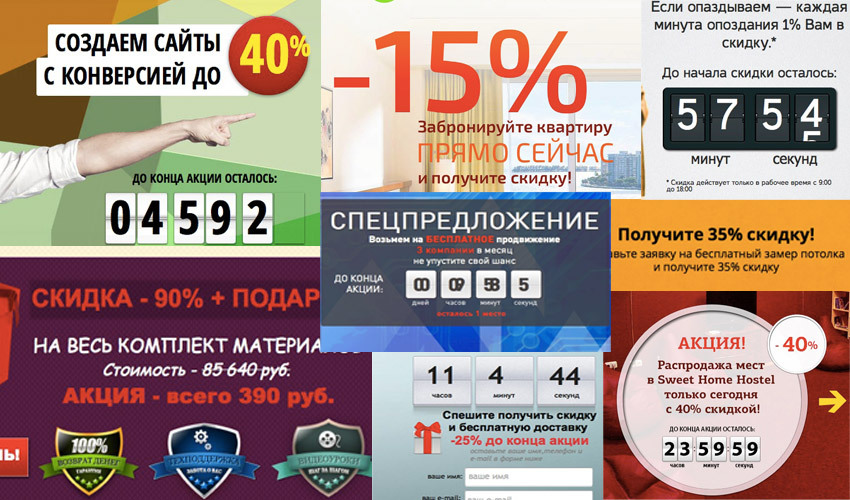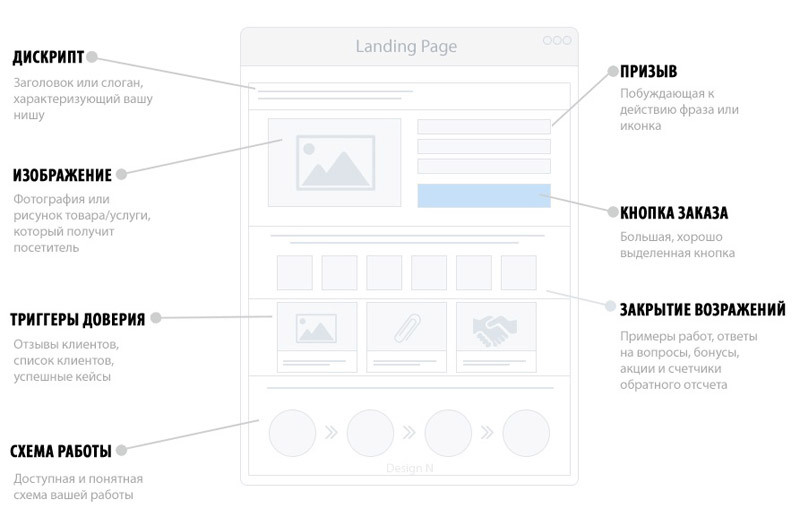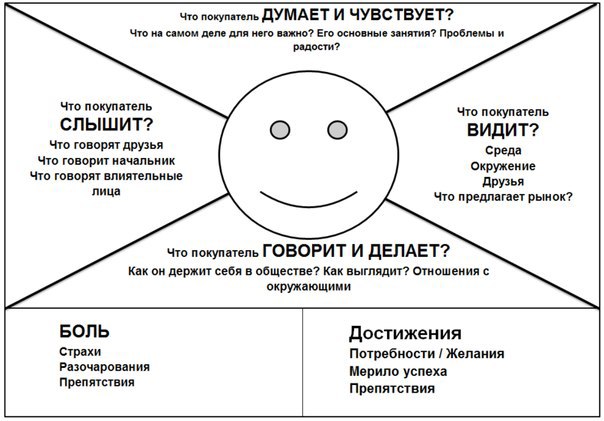Each by Landing Page. Sore
Whether with the filing of Business Youth, or for other reasons, now only lazy does not offer the development of the Landing Page. And for good reason. According to the global idea, a landing page is such a special page that technically must turn visitors into leads with a much greater probability than the site can do in the usual sense.

Satire on most of the "landing page"
Every day, newsites and new landing sites appear like mushrooms after the rain, offering everyone in need to develop a professional landing page that costs from “three kopecks” to breathtaking amounts.
')
With the same speed on the Internet, the secrets of effective landing pages begin to spread, which generally boil down to such a guide:
Particularly resourceful sell bundles of templates “effective landing page”, and someone went even further, and so the market received universal online services for independent “designing” landing page.
More and more “specialists” are trying to assure us that they know how to do a conversion in 40%, explaining this withmagic with the correct technologies of persuasion, special consistency of presentation and understanding of the client’s pain (literal phrase).

Unfortunately, usually, it all comes down to a horse-sized timer, during the validity period of which we are offered a 20-30-50-100% discount, a frying pan and delivery of the Snow Maiden in a bikini.
Of the good hundreds of viewed landing pages about landings, only a small part said at least something about the very objects of influence themselves - you and me, those very mysterious consumers who must easily and naturally leave their contact or perform any other desired action.
Almost every landingpadmaker is happy to talk about techniques of persuasion, large buttons, capacious headers, stylish timers, and so on. But few people even think about why all this is done. The belief to perform this or that action can not be built only on the ball (promotions, discounts) and other dubious techniques.

This Western infographic has become so popular with many CIS studios that every third person considers it his duty to place it on his landing page.
As in the case of the classic design of interfaces (and there is essentially no difference), at the center of the whole process is a collective image - a character with a name, a photo, and even a life story that has its own good reasons to visit your site. The character has a life experience: dreams, fears, doubts, thoughts and actions. Visiting the site, he wants to perform a certain task, for example, buy some product or order a service. He has certain ideas on this subject and depending on how the site meets his expectations - he will perform or does not perform the action we want (that is, he realizes or does not realize his goal on our site).
The task of an experienced designer is to identify these very characters from a multitude of all possible audiences, determine their needs (expectations) and implement the appropriate interface solutions.
And in these interface solutions there may well be neither a timer, nor a stock, nor a discount, but landing will still work with higher returns.
The whole secret lies in correctly understanding the target audience of the product or service and giving the appropriate answers that simply will not leave any other choice how to rejoice and press the coveted conversion button.
And against the background of this simple, but important action, all the pitiful attempts of most landing-paging makers simply boil down to operating with other, lower values. The desire to get cheaper, to save, far from everyone cares and affects only a small share of the audience. In this way, compensating for their own lack of education, these figures bring into the business of their clients a rather dangerous audience, the main value of which is the maximum ball. And this audience will gladly betray the business and leave at the moment to another, unless you make an even bigger discount.
Characters help to abstract from your personal experience, personal experience of your colleagues and design the interface really for the target audience that will use it. The use of characters helps to more deeply understand the needs of the target audience and to identify, at first glance, unexpected solutions. It is also convenient to use characters as a document in defense of interface solutions, when a designer, developer, or God knows who suddenly decides to show imagination and make his own adjustments to the layout.
As in the case of ordinary childbirth, the character is the result of preliminary work, in our case - research.
First you need to conduct a series of interviews with all responsible parties. Such parties may be:
At the same time, if managers are useful for identifying business tasks, then for future characters, the most important ones will be those individuals who directly communicate with customers. Often, consultants and salespeople are more aware of the problems, needs and fears of customers than managers.
The most common mistake of most companies is to try to get information on the brief. So - do not waste paper in vain. You can never get really important and valuable information on the brief. Each business is unique and has its own characteristics that can be caught only in person. Besides, briefs are far from fun to fill out, so usually only short replies or information without any value appear in them.
It is also ideal to conduct interviews directly with the users of the product or service themselves, but usually this task is difficult and increases the project budget several times, so communication with consultants and vendors will be enough.
The detailed nuances of interviewing a business will be postponed until the following material (if you want one).
On the basis of the data obtained, it is possible to quite simply determine groups of users similar in behavior and tasks and select from them those for which the interface will be designed. Each group is a character (collective image).
Now it's up to the Empathy Map. It is necessary for the formation of a full-fledged image of each character and looks like this:

Filling it after the interview will be quite simple and better to do it together.
As a result, the very needs that are needed to create a cool landing page will be recorded in the empathy card. If a full-fledged site is being designed, then work should be continued by creating a perfect journey map (Customer Journey Map). But in the landing page there is one page, so let's drop it.
Now it remains only to prioritize the needs (we close the most important ones immediately, the rest along the way) and compare interface solutions with them.
Now that there is an understanding of the target audience, the characters and their needs, there is a field for real activity. Instead of pushing apart standard blocks like “why 99% of customers choose us”, “rush to share” and so on, you can answer really exciting questions from users and capture a much more valuable audience than those looking for the ball.
And lastly, it should be said that in fact any described technique, be it a timer, a discount offer, or something else, can be an effective tool if used correctly.
For example, when designing a landing page for an SMS distribution service, we found that none of the many competitors offer anything more than just a distribution service. At the same time, from the interview with the business, there was a clear trace of the need to assist clients in learning the right SMS marketing. Such training would not only increase customer loyalty, but also increase the profit of the business itself through more privately distributed mailings. Therefore, we offered the customer a guide to effective SMS marketing and give it to every customer who credited them with a certain minimum amount. Thus, we have formed a UTP (unique selling proposition). Next were designed two versions of the landing. In the first version, the manual is translated as one of the features of the service, in the second, as a UTP with a timer. At the end of the technical implementation, we run the A / B test and determine which option turned out to be the most successful.

In this example, the use of the timer is justified, because the stock is not sucked from the finger, and the proposal has a real value.
The main insider of this article - think ! Stop punching out template solutions without any analytics and preliminary work. Respect yourself and the client's business.

Satire on most of the "landing page"
Every day, new
')
With the same speed on the Internet, the secrets of effective landing pages begin to spread, which generally boil down to such a guide:
- formulate a clear sentence
- limit sentence
- describe why you are the best
- describe the work process
- give social confirmation
- mark bright and noticeable desired action
Particularly resourceful sell bundles of templates “effective landing page”, and someone went even further, and so the market received universal online services for independent “designing” landing page.
Is everything as simple as 1-2-3?
More and more “specialists” are trying to assure us that they know how to do a conversion in 40%, explaining this with

Unfortunately, usually, it all comes down to a horse-sized timer, during the validity period of which we are offered a 20-30-50-100% discount, a frying pan and delivery of the Snow Maiden in a bikini.
Of the good hundreds of viewed landing pages about landings, only a small part said at least something about the very objects of influence themselves - you and me, those very mysterious consumers who must easily and naturally leave their contact or perform any other desired action.
Madness on techniques
Almost every landingpadmaker is happy to talk about techniques of persuasion, large buttons, capacious headers, stylish timers, and so on. But few people even think about why all this is done. The belief to perform this or that action can not be built only on the ball (promotions, discounts) and other dubious techniques.

This Western infographic has become so popular with many CIS studios that every third person considers it his duty to place it on his landing page.
Let's remember the users
As in the case of the classic design of interfaces (and there is essentially no difference), at the center of the whole process is a collective image - a character with a name, a photo, and even a life story that has its own good reasons to visit your site. The character has a life experience: dreams, fears, doubts, thoughts and actions. Visiting the site, he wants to perform a certain task, for example, buy some product or order a service. He has certain ideas on this subject and depending on how the site meets his expectations - he will perform or does not perform the action we want (that is, he realizes or does not realize his goal on our site).
The task of an experienced designer is to identify these very characters from a multitude of all possible audiences, determine their needs (expectations) and implement the appropriate interface solutions.
And in these interface solutions there may well be neither a timer, nor a stock, nor a discount, but landing will still work with higher returns.
The whole secret lies in correctly understanding the target audience of the product or service and giving the appropriate answers that simply will not leave any other choice how to rejoice and press the coveted conversion button.
And against the background of this simple, but important action, all the pitiful attempts of most landing-paging makers simply boil down to operating with other, lower values. The desire to get cheaper, to save, far from everyone cares and affects only a small share of the audience. In this way, compensating for their own lack of education, these figures bring into the business of their clients a rather dangerous audience, the main value of which is the maximum ball. And this audience will gladly betray the business and leave at the moment to another, unless you make an even bigger discount.
Characters help to abstract from your personal experience, personal experience of your colleagues and design the interface really for the target audience that will use it. The use of characters helps to more deeply understand the needs of the target audience and to identify, at first glance, unexpected solutions. It is also convenient to use characters as a document in defense of interface solutions, when a designer, developer, or God knows who suddenly decides to show imagination and make his own adjustments to the layout.
How to "give birth" character?
As in the case of ordinary childbirth, the character is the result of preliminary work, in our case - research.
First you need to conduct a series of interviews with all responsible parties. Such parties may be:
- directors
- managers
- consultants
- sellers
- etc
At the same time, if managers are useful for identifying business tasks, then for future characters, the most important ones will be those individuals who directly communicate with customers. Often, consultants and salespeople are more aware of the problems, needs and fears of customers than managers.
The most common mistake of most companies is to try to get information on the brief. So - do not waste paper in vain. You can never get really important and valuable information on the brief. Each business is unique and has its own characteristics that can be caught only in person. Besides, briefs are far from fun to fill out, so usually only short replies or information without any value appear in them.
It is also ideal to conduct interviews directly with the users of the product or service themselves, but usually this task is difficult and increases the project budget several times, so communication with consultants and vendors will be enough.
The detailed nuances of interviewing a business will be postponed until the following material (if you want one).
On the basis of the data obtained, it is possible to quite simply determine groups of users similar in behavior and tasks and select from them those for which the interface will be designed. Each group is a character (collective image).
Now it's up to the Empathy Map. It is necessary for the formation of a full-fledged image of each character and looks like this:

Filling it after the interview will be quite simple and better to do it together.
We form needs
As a result, the very needs that are needed to create a cool landing page will be recorded in the empathy card. If a full-fledged site is being designed, then work should be continued by creating a perfect journey map (Customer Journey Map). But in the landing page there is one page, so let's drop it.
Now it remains only to prioritize the needs (we close the most important ones immediately, the rest along the way) and compare interface solutions with them.
What to do with all this?
Now that there is an understanding of the target audience, the characters and their needs, there is a field for real activity. Instead of pushing apart standard blocks like “why 99% of customers choose us”, “rush to share” and so on, you can answer really exciting questions from users and capture a much more valuable audience than those looking for the ball.
And lastly, it should be said that in fact any described technique, be it a timer, a discount offer, or something else, can be an effective tool if used correctly.
For example, when designing a landing page for an SMS distribution service, we found that none of the many competitors offer anything more than just a distribution service. At the same time, from the interview with the business, there was a clear trace of the need to assist clients in learning the right SMS marketing. Such training would not only increase customer loyalty, but also increase the profit of the business itself through more privately distributed mailings. Therefore, we offered the customer a guide to effective SMS marketing and give it to every customer who credited them with a certain minimum amount. Thus, we have formed a UTP (unique selling proposition). Next were designed two versions of the landing. In the first version, the manual is translated as one of the features of the service, in the second, as a UTP with a timer. At the end of the technical implementation, we run the A / B test and determine which option turned out to be the most successful.

In this example, the use of the timer is justified, because the stock is not sucked from the finger, and the proposal has a real value.
The main insider of this article - think ! Stop punching out template solutions without any analytics and preliminary work. Respect yourself and the client's business.
Source: https://habr.com/ru/post/226969/
All Articles